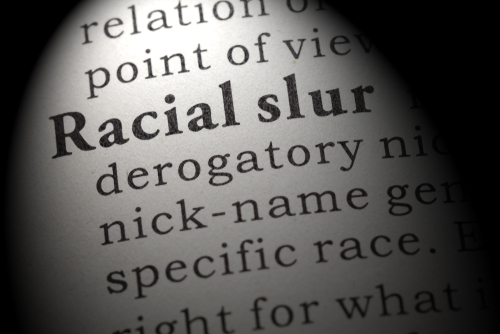
Is a Single Racial Slur Considered Severe Racial Harassment?
- On 19 August 2024
- Posted by Chantal Mariotti
Blog by Matthew J. Roberts, Esq – HR WatchDog
Whether workplace harassment conduct rises to the level of severe or pervasive, as required by California’s Fair Employment and Housing Act (FEHA), is commonly misunderstood, as is what conduct is considered retaliation under the FEHA for workplace harassment complaints. In a recent double whammy decision, the California Supreme Court highlighted how the conduct’s context can result in a very broad array of conduct that results in harassment or retaliation.
Just one instance of using the N-word epithet towards an African American coworker may be severe enough to be unlawful racial harassment in violation of the FEHA (Bailey v. San Francisco District Attorney’s Office, No. S265223 (July 29, 2024)). Additionally, the California Supreme Court held that not properly reporting a racial harassment complaint and continuing to require the complainant to work in close proximity to her harasser may be considered an adverse employment action and thus retaliation in violation of the FEHA.
This case begins in 2015, when a coworker, Saras Larkin, claimed a mouse ran under plaintiff Twanda Baliey’s desk, which startled Bailey. In response, Larkin said “you [N-words] is so scary.” Although offended and upset, Bailey didn’t complain to human resources because she feared retaliation based on prior events when other employees were reassigned or were separated from employment after making harassment and discrimination claims against Larkin. Bailey believed this retaliation occurred because Larkin had a close friendship with Evette Taylor-Monachino, who was the personnel officer responsible for receiving workplace complaints at the San Francisco District Attorney’s office.
Bailey’s supervisor learned of and reported the incident on Bailey’s behalf. Bailey met with Taylor-Monachino, but no complaint regarding the incident was filed with the Department of Human Resources (DHR) — as San Francisco city policy required. When Bailey questioned Taylor-Monachino’s decision to not file the complaint, her behavior towards Bailey changed — she started ignoring Bailey, staring at her rudely, laughing at her and making a comment that a workers’ compensation claim Bailey filed wasn’t “real”.
Eventually, the DHR learned of the incident from a source outside the District Attorney’s office and met with Bailey. After meeting with Bailey, the DHR declined to investigate the complaint because although the N-word is extremely offensive, the single use of it was insufficient to create a hostile work environment. Further, Taylor-Monachino’s refusal to file the complaint was not retaliation as it did not ultimately impair Bailey’s complaint from reaching the DHR, while the rest of Taylor-Monchino’s behavior were mere “social slights.”
Eventually, Bailey filed suit against the City of San Francisco for several FEHA-related claims including racial harassment and retaliation. The trial court dismissed the racial harassment claim because it did not find that the single use of the N-word towards her was sufficiently severe or pervasive. The trial court also dismissed the retaliation complaint because it found that Taylor-Monachino’s conduct — which amounted to social ostracism — did not rise to an adverse employment action motivated by Bailey’s racial harassment complaint. The California Court of Appeal agreed with the trial court. Bailey appealed to the California Supreme Court.
On the first issue of whether the single use of the [N-word] can constitute unlawful racial harassment, the California Supreme Court highlighted that such claims are evaluated in light of the totality of the circumstances, and whether something is severe or pervasive is viewed through the lens of a reasonable person of the group that the conduct targeted. In other words, would a reasonable African American in Bailey’s position find the single use of the [N-word] to be severely offensive creating a hostile work environment?
The city argued that, in the context of this specific work environment, a single use of the [N-word] — although extremely offensive — over a 14-year period cannot reasonably be considered severe under the FEHA. The California Supreme Court disagreed largely because of the fraught history and extreme offensiveness of the slur. It found that a reasonable person in Bailey’s position could find the slur so offensive as to materially affect her employment creating a hostile work environment, in large part because Bailey’s work environment shared close quarters with Larkin, and Bailey could not escape the environment.
A secondary issue arose — under the FEHA, an employer may be strictly liable if a supervisor engaged in the harassing conduct, but for an employer to be liable if a nonsupervisory employee — like Larkin — engaged in the conduct, the employer needs to have ratified the conduct through intentional or negligent means. In this case, the court found that Taylor-Monachino’s conduct of refusing to file a complaint as required undermined the process and could, in effect, ratify Larkin’s racial harassment and make the city also liable for that conduct.
On the retaliation issue, the California Supreme Court disagreed with the lower courts’ characterization of whether Taylor-Monachino’s conduct could constitute an unlawful adverse employment action. While the phrase “adverse employment action” is not defined in the FEHA, the courts have defined it over time to be an action that materially affects the terms, conditions or privileges of employment. To this end, retaliatory acts are not limited to just actions such as demotions, suspensions or the termination of employment. Instead, retaliation may also take the form of a series of “subtle, yet damaging, injuries”.
Bailey argues that Taylor-Monachino’s conduct obstructing her complaint and then her subsequent behavior amounted to punishing Bailey for raising the complaint. The court agreed that in light of the circumstances, Taylor-Monachino’s conduct could rise to the level of an adverse employment action.
In light of its opinion, the California Supreme Court has revived both claims and has remanded the case for further proceedings based on this decision. The decision highlights fundamental and vital aspects of an employer’s harassment, discrimination and retaliation prevention policy.
First, to avoid a dispute over whether conduct rises to severe or pervasive, employers should maintain zero tolerance of any type of conduct motivated by an employee’s protected class under the FEHA. Taking this action will ensure the employer is not found to be negligent in its handling of the conduct and can allow an employer to prevent future instances of conduct that may rise to the level of severe or pervasive.
Second, employers need to have clear procedure for receiving and investigating complaints that are utilized without exception. Taylor-Monachino’s failure to report the incident as required is relevant evidence for both the city’s liability for Larkin’s conduct and retaliation against Bailey.
Lastly, effective and targeted training on these complex issues is always vital to the success of a harassment, discrimination and retaliation policy. Employers should ensure they are not just “checking a box” with their training but utilizing training that educates employees of all levels of what is harassing conduct and how to prevent it in the future.
Matthew J. Roberts, Associate General Counsel, Labor and Employment


